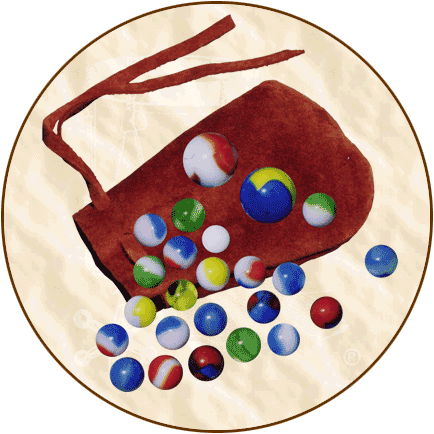.
Continued from product description on
Traditional Games' Page Two...
Historical
Background: The history of marbles dates back to at least
3,000 years ago in ancient Egypt and Rome. The Roman poet Ovid
wrote of the game of marbles. The oldest marbles found so far
were buried with an Egyptian child at Nagada. Marbles from Crete
that date back to 2000-1705 B.C. are displayed in the British
Museum. Marbles have also been found in ancient Native American
earthen mounds in North America. During the reign of Elizabeth
I, tradition has it that a game of marbles was played to win
the hand of a maiden.
The word "marble" was not used to represent the
round toy ball made from various stones until 1694 in England.
It was then that marble stone was being used for the toy and
was being imported from Germany. Before this time, the English
adopted the Dutch word "knikkers" for marbles. The
word "knikker" was used by New York City children well
into the 19th century.
The earliest marbles were made of flint, stone, and baked
clay. For centuries afterward, marbles were made of stone and
sometimes real marble. Glass marbles were made in Venice, Italy,
and later, around 1800, china and crockery marbles were introduced.
A glassblower invented a tool called the "marble scissors"
in 1846 that allowed a larger production of glass marbles. Clay
marbles began being produced in large quantities around 1870.
During the 1890s, the first machines to manufacture glass
marbles were introduced. Martin F. Christensen invented the revolutionary
glass marble-making machine in 1902, and his glass marble company
produced over a million marbles each month. Horace Hill founded
a company named the Akro Agate Company and moved it from Akron,
Ohio, to Clarksburg, West Virginia, because natural gas and sand
were more abundant in that area. By 1920, the Akro Agate Company
was the largest marble producer in the world.
Berry Pink of the Marble King Company helped promote local
and national marbles tournaments in America during the 1920s
and 1930s. The National Marbles Tournament is still held annually
in Wildwood, New Jersey.
Jeff Carskadden and Richard Gartley are recognized mibologists
who have published the most scholarly works to date on the subject
of toy marbles. Their research shows nine marble games that can
be found on 17th- and 18th-century Dutch wall tiles. "Mib"
is the Latin word for marbles; "ology" is Latin for
"the study of."
Marble games can be divided into two types: the games in which
a player tries to knock his opponent's marbles with his own (and
win the marbles), and the games in which a player tries to hit
a target or roll the opponent's marble through a hoop or into
a hole.
There are specific ways to play marbles and to hold what is
called the "shooter marble," which is a larger than
the regular playing marbles. One method of shooting is called
"knuckling"; and another way is called "fulking."
One can also roll or flick the marble until these other two methods
are learned.
Marble terminology:
Shooter -- taw
Alleys -- marbles once made of alabaster
Flints -- marble that look like flint
Cloudies -- marbles that look cloudy
Marbles are definitely a part of America's heritage. They
have been a popular American game from Colonial times to the
present. Norman Rockwell painted a wonderful picture called "Marbles
Champ," which features a little girl winning the marbles
of two forlorn boys. If you are interested in marbles, you can
visit the Marble Museum in Yreka, California or online at www.marblemuseum.org.













